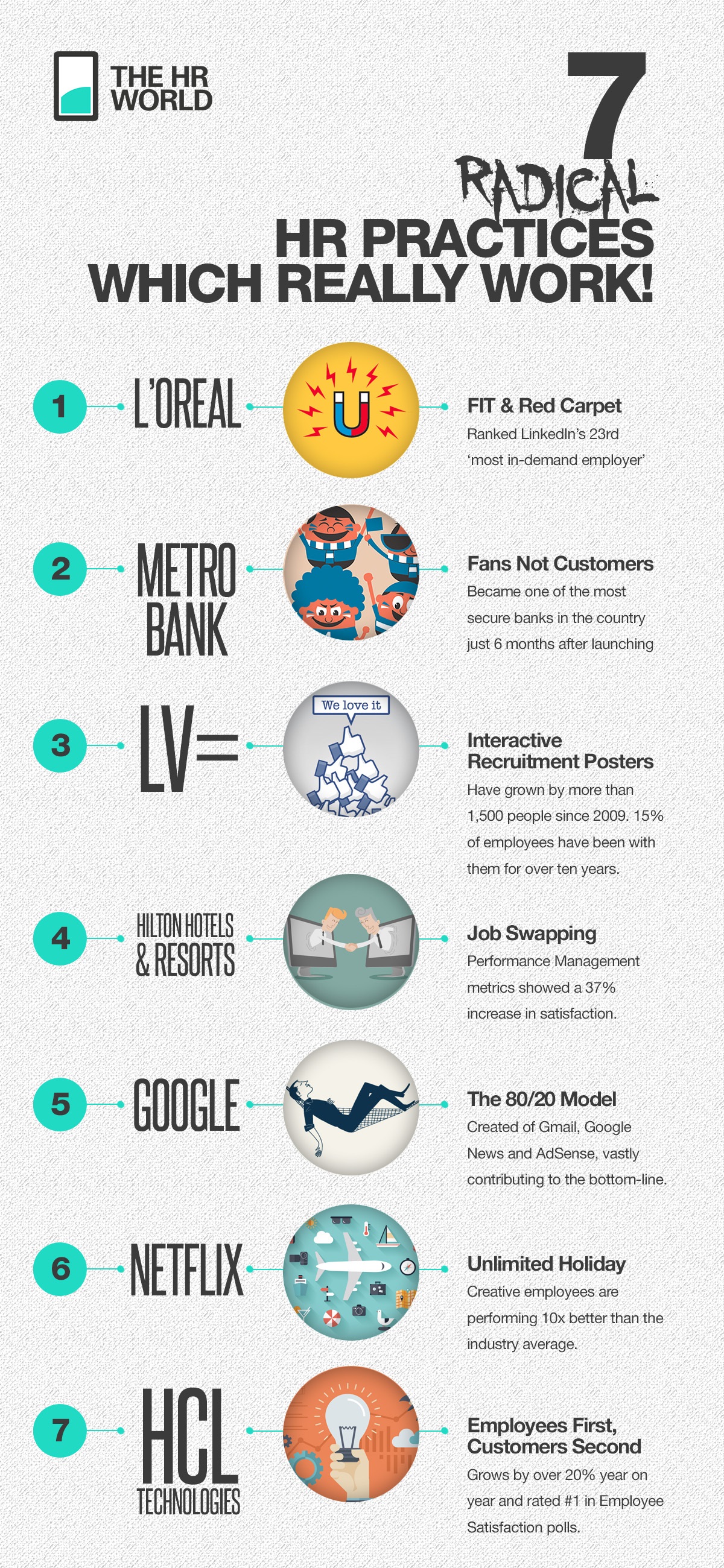- Home
- WELCOME TO THE NEWSROOM
- 7 Radical HR Practices Which Really Work
7 Radical HR Practices Which Really Work
Written by Sanderson Recruitment | Blog | Human Resources | Posted 05/12/2014
2014 has coined a new buzzword; ‘employee experience’. With another addition to the list of ‘fuzzy’ terms HR is asked to define, we have decided to bridge the gap between idealising motivation and the actions which achieve it. It’s easy to throw phrases like ‘holistic HR’ and ‘employee engagement’ around, but do we know what to do with them?
Many companies have grasped it, and are using these ideas to inform both their transactional and strategic HR functions. Here is a number of tried and tested examples of radical HR practices which have been proven to yield quantifiable, valuable results.

- 1. L’Oreal - ‘FIT & Red Carpet’
L’Oreal have developed a ‘two-year orientation programme called FIT (follow-up, integration and track)’, which is at the forefront of their attraction and retention strategy. In light of the fact that turnover is at its most volatile during the first few years of a person’s employment, FIT is a ‘personalised learning and mentoring programme that enables people to decode HR processes and learn [their] culture’. In addition to FIT, they have added an element called ‘red carpet’; an e-learning programme accessible on the web to be completed before arrival, which promotes their mission statement and values to employees before they start.
The Results:
Ranked LinkedIn’s 23rd ‘most in-demand employer’.
2. Metro Bank – ‘Fans Not Customers’
Famous for their dog-friendly policy (biscuits and water bowls in every branch), Metro Bank opened in 2010 and quickly became a ‘big hit with customers keen for a change’. Their online ‘Metropedia’ is an unbelievably simple transactional HR system, designed for anyone to understand in seconds. The HRD, Danielle Harmer, finds that people get it quickly and easily so that they can 'move on to more important things'.
The Results:
In the six months following its launch, it exceeded expectations by becoming one of the most secure banks in the country, with a leverage ratio of 25% and a tier one capital ratio of 63%.
3. LV= - Interactive Recruitment Posters
LV= insurance, the UK’s largest friendly company, used recruitment posters which featured actual employees. If job seekers sent an MMS of the advert, it generated a call from the person featured on the poster, telling them what working for LV= is like. In addition, a staff referral system called ‘work mates’ was imposed, whereby a wide net of staff members were responsible for 14% of new hires.
The Results:
Staff attrition is down from the 52% of five years ago, to just 15.2% today; they have grown by more than 1,500 people since 2009 and 15% of employees have been with them for over ten years.
4. Hilton Hotels & Resorts – Job Swapping
For one day each quarter, the hotel managers are required to ‘totally immerse themselves’ in the day-to-day operations of the hotel. By literally putting their managers in the shoes of their customer service employees, HR aims to improve communications, helping its employees to understand the company’s operations at all levels.
The Results:
Performance Management metrics showed a 37% increase in satisfaction.
5. Google – The 80/20 Model
One of the most famous and successful strategies, the 80/20 model allows workers to dedicate 20% of their working hours to personal projects. The only rule: it must not be related to their main work.
The Results:
The creation of Gmail, Google News and AdSense, vastly contributing to the bottom-line.
6. Netflix – Unlimited Holiday
Popular streaming company Netflix allow their employees to take an unlimited amount of holiday and sick leave. Netflix managers treat their employees like adults, capable of managing their own workload sensibly. They offer instead ‘compelling work, tightknit teams, and performance-based pay’, and employees are simply encouraged to act in the company’s best interests.
The Results:
A mixture of conscience and a desire to earn their holiday through higher achievement made creative employees 10x better than the industry average.
7. HCL Technologies – ‘Employees First, Customers Second’
Indian global IT services company HCL holds employee experience as its ‘strategic backbone’. Led by Vineet Nayar, they champion the philosophy ‘employees first, customers second’. Through a regular internal blog, Navar himself encourage employees feel comfortable enough to raise any issue, and constantly asks for feedback on how he and the board could improve.
The Results:
HCL grows by over 20% year on year; they hired 8,000 people in last quarter of 2010 alone, and rated #1 in Employee Satisfaction polls.